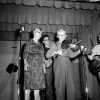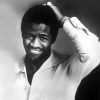calsfoundation@cals.org
Edward Lawrence (Ed) Stilley (1930–2019)
Edward Lawrence (Ed) Stilley was a farmer and instrument maker from Hogscald Hollow (Carroll County). In 1979, according to Stilley, he received a directive from God to make and give away musical instruments to children. Without any prior knowledge of instrument making, he created and gave away over 200 instruments, only stopping in 2004 when his hands could no longer do the work required to build them.
Ed Stilley was born on July 27, 1930, in Carroll County, the third child of six. His parents were William Stilley, who worked at a sawmill, and Sarah Parker Stilley. Stilley was partially raised by a longtime resident of Hogscald, Anna Frances “Fannie” Prickett. Prickett was an elderly woman who lived alone and needed help running her farm. In 1959, Stilley married Eliza Miller. He built a home at Hogscald, just across the “scalds” from Prickett, where he and Eliza raised five children. (Hogscald Hollow has several large holes, or scalds, in the rock bed where, historically, hot rocks were placed to heat the water. That scalding water was used to help remove hair from wild hogs that had been put in the water, hence the name Hogscald Hollow.)
In addition to subsistence farming, Stilley worked at a sawmill for many years and did odd jobs after the mill closed.
According to Stilley, in 1979, he received a vision from God directing him to build and give away instruments to children. Over the years, several versions of the events surrounding his vision have been shared by Stilley, and subsequently others. One account is that Stilley lay down to rest during a time of great turmoil and entered a deep sleep, whereupon he received the directive that, if he made and gave away instruments, his health would be restored. Another account involves him falling asleep with a gun close by for protection. A third account has the encounter taking place when he felt he was having a heart attack while plowing. He lay on the ground and had a vision of himself as a tortoise in a raging river, with his children as smaller tortoises on his back. Yet another version involves a petition circulated around the Hollow wanting him to preach a certain way. The one common element to all these accounts is that, in his vision, God told him that if he made and gave away instruments, his family would be taken care of or the matter would be resolved.
Shortly after his vision, he started constructing guitars, banjos, fiddles, and other stringed instruments from wood and metal scraps he found on his property. He had no knowledge of traditional instrument-making methods, nor much in the way of tools. To form an instrument’s sides, he boiled an oak slab in a steel drum overnight. Using a pegboard, he started to bend the slab, and wherever it started to break, that is where he stopped. He then cut a top and bottom to fit the sides. Many of his early instruments have a flat top and bottom. Over time, he began to bend the top and bottom to fit arched braces that spanned his instruments. On the top of many of his instruments, he routered the words “True Faith True Light Have Faith in God.”
Stilley’s instrument styles can be divided roughly into three periods. In the early period, many of his instruments have metal faceplates but lack any lettering on the top, which became almost universal in later periods. He was largely just attempting, as he phrased it, to “get the sound out.” The middle period was one of exploration and experimentation. Metal objects, such as saw blades and springs, started to appear in his instruments. In the later part of the middle period, he started using barn paint on his instruments, continuing this throughout the late period. In addition, the late period featured more standardization of the internal structure using a circular saw blade, door springs, and an aluminum echo tube.
The major musical characteristic that dominates many of Stilley’s instruments is the reverb that the alignment of metal parts creates. Reverb is a sound that continues after the source of the sound, in this case the movement of the strings, stops. Another unique feature is the “jingler,” which is a piece of scrap metal that sits under the fingerboard and “dances” with the vibration of strings. This vibration travels down the truss rod and into the body of the instrument.
Stilley’s craft gained public awareness through the work of Kelly and Donna Mulhollan, folk musicians who perform as Still on the Hill and who met the Stilleys through mutual friends. Flip Putthoff, a photojournalist for what was the then the Morning News of Northwest Arkansas, did a story on Stilley in 1997. The Old State House in Little Rock (Pulaski County) hosted an exhibition of his work from 2016 to 2018. The Shiloh Museum of Ozark History in Springdale (Washington and Benton counties) hosted an exhibition of his work from 2019 to 2020.
In 2004, Stilley stopped creating instruments as his hand could no longer do the detailed work required. After he retired from instrument making, he and Eliza moved from Hogscald but remained in the area. He died on June 12, 2019, in Fayetteville (Washington County).
For additional information:
“Ed Stilley.” Still on the Hill. http://www.stillonthehill.com/edstilleyabout (accessed March 24, 2023).
Hawley, Tim. Gifted: The Instruments of Ed Stilley. Chicago: Press Syndication Group, 2015.
Motherwell, David. “Ed Stilley Is One of a Kind.” Carroll County Historic Quarterly 63 (June 2018): 6–8.
Mulhollan, Kelly. True Faith, True Light: The Devotional Art of Ed Stilley. Fayetteville: University of Arkansas Press, 2015.
Obituary of Edward Lawrence Stilley. https://www.nelsonfuneral.com/obituaries/Edward-Lawrence-Stilley?obId=4485565#/obituaryInfo (accessed March 24, 2023).
True Faith, True Light: The Devotional Art of Ed Stilley. Old State House Museum. http://collections.oldstatehouse.com/exhibitions/96/true-faith-true-light-the-devotional-art-of-ed-stilley/objects (accessed March 24, 2023).
Aaron Loehndorf
Shiloh Museum of Ozark History
 Divergent Prosperity and the Arc of Reform, 1968–2022
Divergent Prosperity and the Arc of Reform, 1968–2022 Folklore and Folklife
Folklore and Folklife Music and Musicians
Music and Musicians Ed Stilley
Ed Stilley 



Fannie Prickett was my great-grandmother so I grew up knowing Ed Stilley. He and his family would come to my grandparents’ and play hymns on the front porch with it echoing through the hollow. Beautiful memories!!!!!